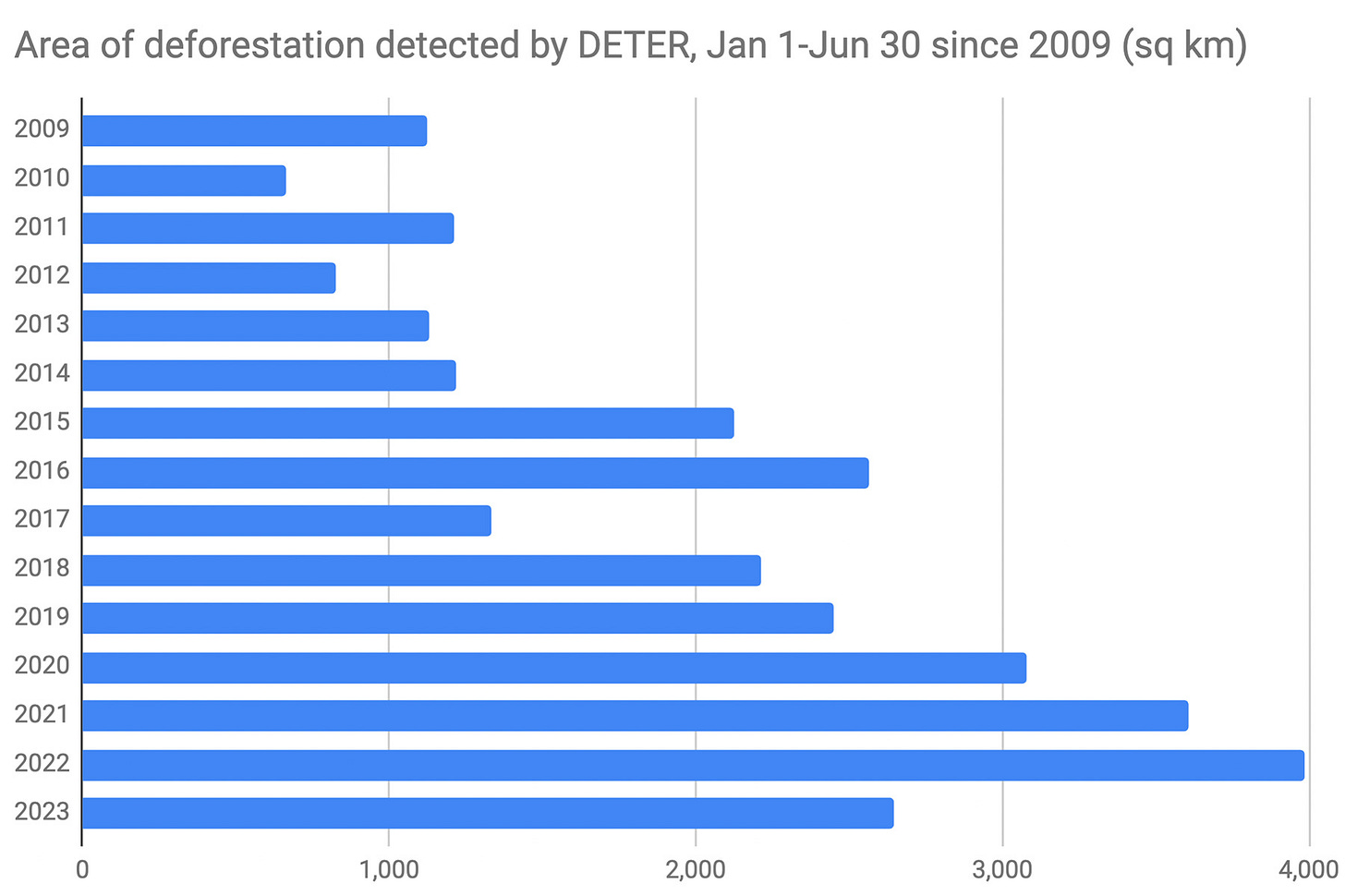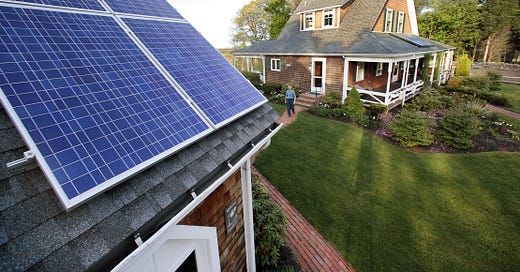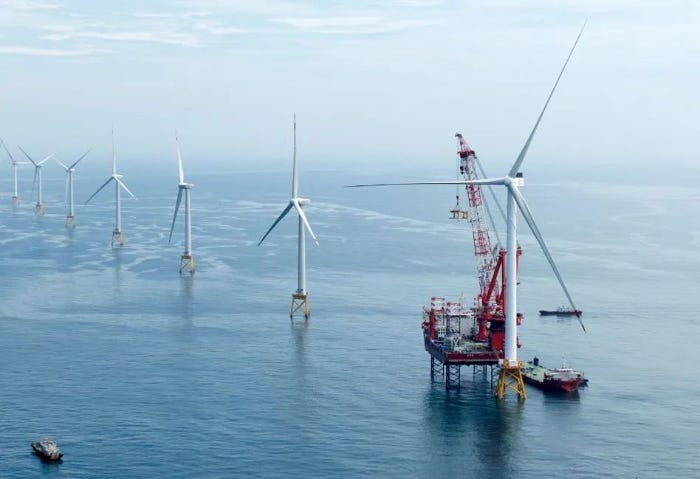The Weekly Anthropocene, July 12 2023
Lula brings a new dawn for the Brazilian Amazon, rooftop solar shuts down a natural gas plant in New England, China's breathtaking renewables boom, and more!
Brazil
In January 2023, Lula da Silva took office as President of Brazil, replacing the infamous Jair Bolsonaro, who openly encouraged illegal logging and mining in the Amazon Rainforest and presided over a surge in deforestation. In the early months of 2023, Lula took a wide range of legal, regulatory, and administrative actions to stop surging deforestation, from restarting anti-illegal logging patrols to reconnecting with foreign governments’ conservation donor programs. Now, six months into Lula’s third term (he was previously President of Brazil from 2003 through 2010, during which time Amazon deforestation sharply declined), things are looking up for Earth’s largest rainforest.

Deforestation rates have dropped sharply as the Brazilian government gets back in the business of enforcing the law in the Amazon. The DETER deforestation tracking system found (pictured) that 2,649 square kilometers of the Brazilian Amazon were cut down in the first half of 2023, down 34% from the nearly 4,000 kilometers cut down in the first half of 2022.
Lula has sent in the Brazilian military to protect the Yanomami indigenous people from genocidal attacks by illegal miners in their territory, and although violence is ongoing, an estimated 75 to 80% of the miners were driven out between February and June.
Providing some longer-term security, Brazil’s electoral court has banned Bolsonaro from running for office for eight years, with 15 other cases pending for Bolsonaro’s many crimes. (The United States sadly lacks a similar institution).
And there’s potential for a lot more progress to come. In June, Lula’s administration unveiled a wide range of plans for future initiatives to be rolled out in the coming years, including a tracking system for wood and agricultural projects to prove deforestation-free origin, new incentives for forest restoration, more support for infrastructure, ecotourism, and sustainable forest product industries, further anti-crime measures, and more. All together, they hope that this might be enough to meet Brazil’s pledge to end Amazon deforestation by 2030.
A strong start. For the sake of Brazil and the world, this writer hopes that Lula’s leadership continues to bear fruit.
United States
Mystic Generating Station, a 1,413-megawatt natural gas-burning power plant situated on the edge of Boston, Massachusetts, is one of the biggest greenhouse gas emitters in New England. For years, electricity customers in the six-state region have been paying a subsidy to keep the elderly facility operating.
Now, the grid operator ISO New England has determined that it can (and will) be safely shut down in 2024 without risking blackouts, thanks to two burgeoning sources of clean power: rooftop solar and the offshore wind. ISO New England estimates that there are now 5,400 megawatts of solar power providing clean electrons in the region (the vast majority of it on private individuals’ rooftops), and the 800-megawatt 62-turbine Vineyard Wind farm, currently under construction off the south coast of Massachusetts, should be providing electricity to the grid by 2024.
This is good for New Englanders, as well as a milestone moment for rooftop solar in the US in general: historically viewed as a “small” source of energy, it’s now been evaluated as big enough to help replace a major fossil fuel plant. Great news!
The Fish and Wildlife Service recently released new regulations based on Section 10 (j) of the Endangered Species Act (ESA), which will for the first allow “experimental populations” of endangered species to be established outside their historic range. This sounds like the epitome of bureaucratic tedium, but it actually represents a paradigm shift in wildlife conservation thinking that will help make possible a multitude of new projects to help America’s animals and plants survive the Anthropocene.
Section 10 (j) is the ESA provision that allows the reintroduction of endangered species into areas where they used to live but have disappeared, like the classic case of wolves returning to Yellowstone. Allowing projects like this to take place in areas where the endangered species at issue hasn’t previously lived is a critical legal tool to allow conservationists to proactively adapt to the changing landscapes of the Anthropocene. Climate change is forcing many creatures to move north, inland, or otherwise into new realms, and the US government is now able to help them do that. For example, a translocation project is already being considered for the Key deer, a diminutive white-tailed deer relative native to the Florida Keys whose historic range is at risk of becoming uninhabitable (for the deer) due to saltwater intrusion from sea level rise. It will also help species like the Guam rail and Guam kingfisher, birds whose eponymous island is no longer safe due to the invasive brown tree snake. Under the new rules, they could get a chance to start fresh on a new, snake-free Pacific island.
Moving into pure speculation, this writer hopes to see their home state of Maine, with its plentiful wild spaces and relatively cooler temperatures, become a new “climate refugia” habitat for endangered species from southern New England, the mid-Atlantic region, and even the South. Starting with more spatially proximate states, a quick review of FWS records reveals that there are 10 endangered species found in Massachusetts but not in Maine: the dwarf wedgemussel, American chaffseed, Northeastern bulrush, sandplain gerardia, seabeach amaranth, American burying beetle, Northeastern beach tiger beetle, Puritan tiger beetle, bog turtle, and Plymouth redbelly turtle. It would now be legally possible for any or all to be introduced into Maine in a (purely hypothetical) future climate adaptation program, to help these creatures benefit from temperatures closer to the ones they evolved in, plus more wilderness areas1. This new regulatory tweak opens up fascinating possibilities for truly proactive conservation efforts across Anthropocene America, and will hopefully resonate for decades to come.
China
China is building truly vast amounts of renewable energy, and the pace is continuing to accelerate. A new analysis has calculated that China is on course to generate 1,200 gigawatts (1,200,000 megawatts) of power from wind and solar alone by 2025-five years earlier than their 2030 goal. (Here’s the full report from Global Energy Monitor). For context, at the end of 2021, the entire United States had just under 1,200 gigawatts of electricity generating capacity, from all sources of energy combined.
Although China is still building more coal plants as well, in fact six times as many new coal plants than the rest of the world combined, it’s possible that much of it may end up not being used, as renewables increasingly predominate and many Chinese coal plants are already loss-making. Massive utility-scale solar and wind farms are under construction in China’s northwestern deserts, rooftop solar is spreading rapidly through China’s cities, and offshore wind projects sprouting along the coasts.
Just one example of what’s happening: at a 400-megawatt offshore wind farm in the waters Fujian Province, the world’s largest wind turbine was installed on June 28, 2023. The single turbine (pictured above) was 146 meters high at the hub, with a 252-meter blade diameter, and generated 16 megawatts all by itself.
Antarctica
Sea ice in Antarctica has undergone a shockingly rapid decline in 2023 so far. On June 12th, Antarctic sea ice spanned an area of 10.7 million square kilometers, 1.15 million less than the previous record-low for that date (in 2019) and 2.3 million less than the 1981-2010 average. For context, 2.3 million square kilometers is an area substantially larger than Mongolia-a large amount of sea ice is missing. Furthermore, Antarctica is in the Southern Hemisphere, so this is all occurring during the depths of winter.
This is clearly due to climate change, but scientists aren’t yet certain exactly what combination of oceanic and atmospheric shifts have caused Antarctic sea ice to decline so rapidly in recent years (after little change for decades before that, even while Arctic sea ice consistently declined), nor what effects this will have on coastal glaciers and global sea level rise. Alongside record-high heat waves around the world2 and unprecedently chaotic jet streams throughout Earth’s atmosphere, early 2023 has been a “blaring alarm” for climate change3. This is why decarbonization is so important, folks!
To be clear, I know of no plans whatsoever to do this, and it may well not even be a good idea for those particular species: it’s just an example of the kind of thing that could be possible now!
Monday, July 3rd, 2023 was the hottest day ever recorded in human history by global average temperature…until that record was broken on July 4th, 2023. As climate writer Bill McKibben put it in a scintillating article: “The best estimate of climate scientists is that Monday was the hottest day since sometime in the last interglacial period 125,000 years ago, right about the time that other scientists think humans etched the first symbols onto bone and started wearing shells as decorations. In other words, a pretty significant record. A pretty significant record that lasted 24 hours.”
The Weekly Anthropocene normally focuses on underreported climate and biodiversity progress (of which there is a lot), but the record-breaking climate disruptions of mid-2023 warrant a highlight.










I am super duper glad that Bolsonaro is out of power. I just wish his replacement wasn't a complete populist, but this is about as good as we can hope for in South America for the time being. I'll take it.
Great news overall- especially from China! At the rate they're going, they may dismantle those coal plants before they even put them into operation! What's going on in India, clean energy generating wise?